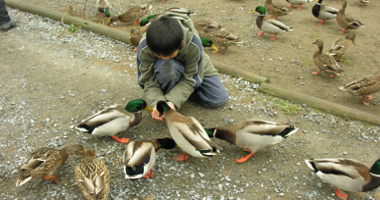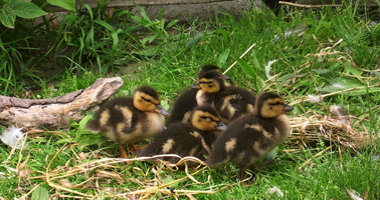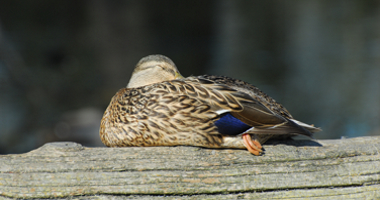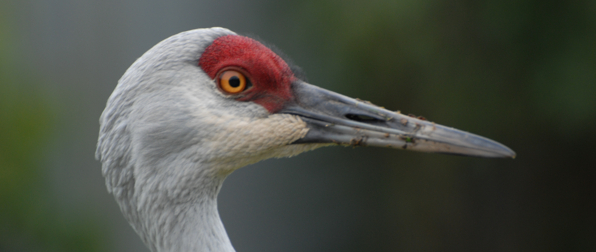Sandhill Cranes

Sandhill cranes are very tall wading birds with a wingspan of close to 2 meters. The nearest species in size and shape is the Great Blue Heron. Although they are similar, the two species can be told apart by head colouring and posture. Sandhill Cranes have a red patch of unfeathered skin on their forehead and a generally grey body. During the breeding season, cranes dab mud on their feathers and are often stained a rusty colour on their bodies as a result.
There are fossil remains dating back 2.5 million years ago identical to modern sandhills of today. They are named after their representative habitat, the sandhills of Nebraska, where over 500,000 cranes congregate during migration. This is the largest sand dune formation in the western hemisphere, consisting of more than 50,000 hectares of rangeland and native prairie vegetation covering sand deposits drifted from the past ice age. It is dotted with hundreds of small wetlands, and the underlying Ogallala Aquifer provides water for 20% of the irrigated land in the USA.
In Canada, the greater majority of cranes migrate through the central prairies and winter in the southern states. In BC, cranes pass through the central interior, migrating between wintering areas in Texas and nesting areas in the bogs and marshes of Alaska and the Yukon. Along the coast, migrant cranes pass over Vancouver Island and the Queen Charlottes. In the Lower Mainland, we see small migrant crane flocks during the fall and winter stopping for brief visits to the Sanctuary or nearby fields of the Fraser River Delta.
When it comes to nesting, cranes are selective and need very large territories (often several hundred hectares) in large open wetlands. In the Lower Mainland, this species has generally chosen the wilder peatlands of the Pitt Valley, Douglas Island, Derby Reach , Burns Bog, and parts of Richmond. There have been cranes here at the Sanctuary for over 30 years. Two "imprinted" cranes were brought here after being hatched in captivity and bonding to people instead of their own kind. Neither of these initial cranes nested successfully and they have long since died, but they did manage to attract wild cranes to the place. A wild male crane joined one of these birds in 1992 and eventually brought its own mate to the Sanctuary and took up year-round residency, nesting sucessfully in 2000. This wild male remained at the Sanctuary until he died in early 2017. We think he was at least 27 years old. The resident female now has a very young mate as a replacement.
The newly formed pair nested in 2017, but the young colt did not survive. In April 2018, the pair nesting in the cattail marsh to the north of their usual island in Display Ponds, but the nest was predated. They re-nested the next month on their usual island, and hatched two chicks or "colts" (June 11th and 13th). The older colt was predated, but the younger one (nicknamed "Louie") grew to adult size and fledged andstayed in the Sanctuary unti 2021, eventually learning to keep away from its parents when they were trying to nest. Each spring our pair chases out all other cranes, including their own young from previous years, and defends the 300 hectare Sanctuary as their territory. Eventually they were successful in chasing off Louie in time to hatch more colts in 2021. If you would like to see many photos of Louie from hatch until early 2019, many images were posted to a Flickr group page set up just for the 2018 colts. Visit the page at https://www.flickr.com/groups/3795095@N22/.
Except during the nesting season, we can regularly have small groups of extra cranes here in addtion to our nesting pair. For years, for example, there were as 6 or 7 additional birds coming and going all throughout the year which were young from previous years or young from a related pair nesting in Richmond. Other cranes also congregate here from late summer to late fall prior to migration. By November, numbers generally drop to just our resident pair plus a select small group of visiting birds that then spend the winter together. In February 2019, for example, there were 14 additional cranes plus our pair and the 2018 colt. In the group of 14 there were 4 other colts. In November and December of 2020, there were 10 regularly present.
After Louie in 2018, the pair was not successful in raising a chick to maturity until the 2021 nesting season. One of the two chicks survived, and we named him Evan. Evan has loitered with his parents since he was able to fly in the fall of 2021. Each spring, he has been a major distrction for the pair, hanging around their nesting territory and seeking attention from them.Generally, they have tolerated this, as it may be part of the mentoring of their offspring until t said bird is officially sexually mature by year 3. We predict in 2024, he will be regarded as a threat to their territory and will be strenuously evected by the pair for the whole nesting neason, so they may successfully be able to hatch and rear a new chick.



























 Sandhill Cranes are very protective of nest sites, their mate and young, and can attack visitors if a threat is perceived. Visitors tend to crowd around this very photogenic family, causing the birds significant distractions while tending their young. For these reasons, it is necessary to close trails for a few weeks right after the nest hatches, and to have volunteer wardens present near the cranes until the young are able to fly. This is for the safety of visitors and the well-being of the cranes. Please respect all signs, barriers and instructions related to these birds.
Sandhill Cranes are very protective of nest sites, their mate and young, and can attack visitors if a threat is perceived. Visitors tend to crowd around this very photogenic family, causing the birds significant distractions while tending their young. For these reasons, it is necessary to close trails for a few weeks right after the nest hatches, and to have volunteer wardens present near the cranes until the young are able to fly. This is for the safety of visitors and the well-being of the cranes. Please respect all signs, barriers and instructions related to these birds.  Sandhill Cranes keep their young with them until the following spring. The young cranes or "colts" have provided Sanctuary visitors with endless entertainment as they learn how to feed, fly, find shelter during winter weather and mimic the courtship dance and calls of the parent birds.
Sandhill Cranes keep their young with them until the following spring. The young cranes or "colts" have provided Sanctuary visitors with endless entertainment as they learn how to feed, fly, find shelter during winter weather and mimic the courtship dance and calls of the parent birds.